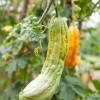 Bitter melon, a tropical and subtropical cucurbit, is widely grown in Asia, Africa, and the Caribbean for its edible fruit. Rich in vitamins A and C, iron, and phosphorus, it contains a compound (charantin) that has been used to lower blood sugar levels to treat diabetes. Two major types of bitter melon, Chinese and Indian, are grown in South Florida year-round. This publication describes common diseases and provides recommendations for their control. This 3-page fact sheet was written by Shouan Zhang, Mary Lamberts, and Gene McAvoy, and published by the UF Department of Plant Pathology, October 2012.
Bitter melon, a tropical and subtropical cucurbit, is widely grown in Asia, Africa, and the Caribbean for its edible fruit. Rich in vitamins A and C, iron, and phosphorus, it contains a compound (charantin) that has been used to lower blood sugar levels to treat diabetes. Two major types of bitter melon, Chinese and Indian, are grown in South Florida year-round. This publication describes common diseases and provides recommendations for their control. This 3-page fact sheet was written by Shouan Zhang, Mary Lamberts, and Gene McAvoy, and published by the UF Department of Plant Pathology, October 2012.
http://edis.ifas.ufl.edu/pp300
Tag: Cucurbit Pest Management
Recommendations for Management of Whiteflies, Whitefly-transmitted viruses, and Insecticide Resistance for Production of Cucurbit Crops in Florida (EENY478/IN871)
 Until recently, squash has been the only cucurbit crop seriously affected by the B biotype of the sweetpotato whitefly, also known as the silverleaf whitefly, because of the silverleaf disorder induced by feeding of the immature stages (nymphs). However, three viruses transmitted by the whitefly have been identified in watermelon, muskmelon, and squash in Florida since 2004, making whitefly management a priority for most cucurbits. This 8-page fact sheet details the current UF/IFAS recommendations for managing whitefly-transmitted viruses and for delaying the development of resistance to insecticides in the whitefly vector. Published by the UF Department of Entomology and Nematology, July 2011.
Until recently, squash has been the only cucurbit crop seriously affected by the B biotype of the sweetpotato whitefly, also known as the silverleaf whitefly, because of the silverleaf disorder induced by feeding of the immature stages (nymphs). However, three viruses transmitted by the whitefly have been identified in watermelon, muskmelon, and squash in Florida since 2004, making whitefly management a priority for most cucurbits. This 8-page fact sheet details the current UF/IFAS recommendations for managing whitefly-transmitted viruses and for delaying the development of resistance to insecticides in the whitefly vector. Published by the UF Department of Entomology and Nematology, July 2011.
http://edis.ifas.ufl.edu/in871
Management of Gummy Stem Blight (Black Rot) in Cucurbits in Florida (PP280)
Gummy stem blight (GSB) is a major disease of many cucurbits, including watermelon, cantaloupe, cucumber, pumpkin, squash, muskmelon, and other melons. The disease is also known as black rot due to its characteristic appearance on infected fruits. Learn the symptoms, causal agent and disease spread, and fungicides labeled for use in Florida. This 9-page fact sheet was written by Mathews L. Paret, Nicholas S. Dufault, and Stephen M. Olson , and published by the UF Department of Plant Pathology, January 2011.
http://edis.ifas.ufl.edu/pp280
HS1172 Florida Pusley Biology and Control in Fruiting Vegetables, Cucurbits, and Small Fruits
HS1172, a 3-page illustrated fact sheet by Andrew W. MacRae, describes this drought-resistant annual with hairy leaves and stems that is common in row middles, strawberry production fields, and organic mulch for highbush blueberries — classification, seedling identification, mature plant, management considerations, and classical control. Includes reference. Published by the UF Department of Horticultural Sciences, May 2010.
http://edis.ifas.ufl.edu/hs1172
HS190/WG029 Weed Control in Cucurbit Crops (Muskmelon, Cucumber, Squash, and Watermelon)
Revised! HS-190, a 6-page fact sheet by William M. Stall, describes effective weed management practices for cultivation of cucurbit crops in Florida, and a table of chemical weed controls. Published by the UF Department of Horticultural Sciences, April 2009.
http://edis.ifas.ufl.edu/WG029
ENY-847/IN761 Biology and Management of Aphids in Sustainable Field Production of Cucurbits
ENY-847, a 3-page illustrated fact-sheet by O. E. Liburd and T. W. Nyoike, provides information about aphids, their biology and lifecycle, damage, monitoring and management strategies for sustainable agriculture. Includes references. Published by UF Department of Entomology and Nematology, January 2008.
http://edis.ifas.ufl.edu/IN761